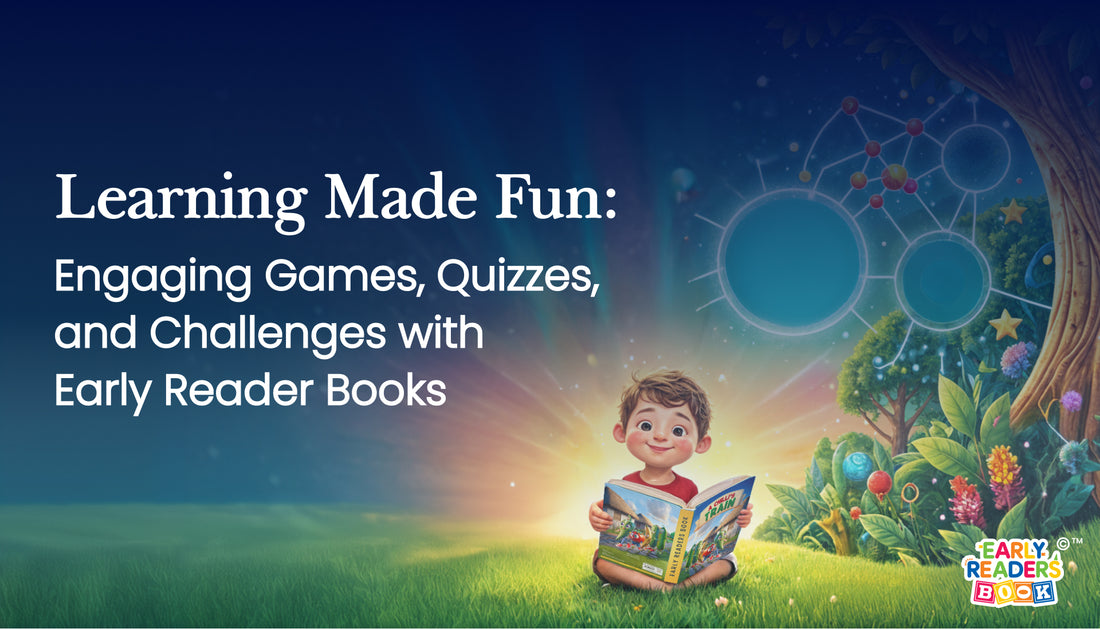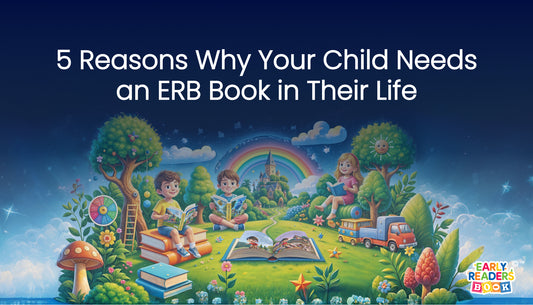
Learning Made Fun: Games, Quizzes, and Challenges with Early Reader Books
Traditional learning methods often rely on textbooks, worksheets, and memorization. While these approaches have their place, they can sometimes feel like a chore for young children. This sense of monotony can lead to discouragement and a lack of motivation, making it challenging to keep children engaged in the learning process.
Early Reader Book (ERB) offers a refreshing solution that goes beyond static books. By integrating interactive games, quizzes, and challenges into the reading experience, ERB provides a fun and engaging way for children to learn. This innovative approach transforms traditional reading into an immersive adventure, cultivating a love for learning and making education an enjoyable part of a child's day.
The Limitations of Traditional Learning Methods
Traditional learning methods typically involve rote memorization, which requires children to learn information through repetition, often without understanding the underlying concepts. This method can be effective for short-term retention of facts but does little to nurture deep comprehension or critical thinking skills. Repetitive exercises, while useful for practice, can become monotonous and fail to engage children's curiosity or creativity.
Challenges Faced
Children face several challenges with traditional learning methods, including a lack of motivation and difficulty in retaining information. When learning activities are not stimulating, children may become disinterested, resulting in poor academic performance and a negative attitude toward learning. Moreover, rote memorization often leads to surface-level learning, making it hard for children to recall and apply information in different contexts. Traditional methods also do not cater to different learning styles, leaving some students at a disadvantage and obstructing the development of critical thinking and problem-solving skills.
By recognizing these limitations, it becomes clear that a more interactive and engaging approach, such as that offered by ERB, is necessary to cultivate a more effective and enjoyable learning experience.
Introduction to ERB's Interactive Features
Early Readers Book (ERB) transforms traditional reading by incorporating a variety of interactive features designed to engage and educate young readers.
- Games: ERB books include various games, such as matching activities, puzzles, and interactive mazes, that are effectively integrated into the storylines. These games require children to engage actively with the content, improving their understanding and retention of the material.
- Quizzes: At different points in the story, ERB presents quizzes that test comprehension and reinforce key concepts. These quizzes are designed to be fun and challenging, encouraging children to recall and apply what they have learned.
- Challenges: ERB books also feature story-based challenges that require children to solve problems or complete tasks to advance the narrative. These challenges are often related to the plot, making them an integral part of the reading experience.
These interactive elements are woven into the fabric of the stories, making sure that they complement and uplift the narrative rather than distract from it. Each interactive feature is designed to be a natural extension of the storyline, making learning an immersive and enjoyable experience.
Purpose and Benefits
The primary purpose of ERB's interactive features is to reinforce learning by engaging children in a way that traditional methods often fail to achieve.
- Reinforcement of Learning: By integrating games, quizzes, and challenges into the stories, ERB helps children reinforce the concepts they are learning. This repetition through play aids in the retention of information and deepens understanding.
- Maintaining Interest and Motivation: Interactive elements are inherently engaging, capturing children's attention and maintaining their interest. This dynamic approach prevents boredom and discouragement, common issues with traditional learning methods.
- Encouraging Active Participation: Unlike passive reading, interactive features require children to actively participate in the learning process. This active engagement promotes critical thinking and problem-solving skills.
- Adaptation to Different Learning Styles: Interactive features cater to various learning styles, making it easier for all children to grasp and retain information. Visual learners benefit from animations and illustrations, while kinesthetic learners engage with hands-on activities.
By incorporating these interactive elements, ERB ensures that learning is not only effective but also enjoyable. The blend of education and entertainment promotes a positive attitude towards learning, encouraging children to explore and discover new things continuously. This innovative approach helps develop essential cognitive, language, and social-emotional skills, making ERB an ideal tool for early childhood education.
Exploring Additional Learning Areas Through ERB
ERB games and activities effectively introduce children to fundamental concepts in science and history. By embedding educational content within engaging storylines, ERB helps children learn about the world around them in a context that is both meaningful and memorable.
- Science: ERB books might include stories where characters explore the natural world, learning about plants, animals, weather, and basic principles of physics. For example, a story about a character going on a nature hike could introduce concepts like photosynthesis, ecosystems, and the water cycle.
- History: Historical stories can transport children to different times and places, teaching them about significant events and figures. An ERB book might feature a time-traveling adventure where children learn about ancient civilizations, important historical milestones, or famous inventors and their contributions.
By integrating these subjects into the narrative, ERB makes sure that learning science and history is not only educational but also enjoyable.
Furthermore, ERB also covers other essential subjects such as math and geography. Interactive features within the stories help children grasp these subjects in an engaging manner.
- Math: Stories may incorporate math challenges where characters need to solve problems to progress. For instance, a treasure hunt story might include puzzles that require basic arithmetic or logical reasoning.
- Geography: Geographic concepts can be woven into stories that involve travel and exploration. Children might learn about different countries, cultures, landmarks, and geographic features as they follow the characters on their adventures.
Diverse and Comprehensive Learning
Integrating various subjects into ERB stories provides a holistic learning experience. Children are exposed to a broad range of knowledge areas, making their education diverse and comprehensive. This interdisciplinary approach helps develop well-rounded learners who are curious about multiple fields and capable of making connections across different subjects.
By covering a wide array of topics, ERB offers children a balanced education that caters to their diverse interests and learning needs. This approach not only makes learning more engaging but also prepares children with a solid foundation of knowledge that they can build upon as they grow.
The Impact of Fun Learning on Child Development
Igniting a Desire to Learn
When learning is fun, children are naturally more inclined to engage with educational content. ERB’s interactive features, such as games and challenges, transform the learning process into an enjoyable activity. This positive experience can ignite a desire to learn more, as children associate education with enjoyment rather than a chore.
Developing a positive attitude towards learning has significant long-term benefits. Children who enjoy learning are more likely to be curious, motivated, and persistent in their educational pursuits. This enthusiasm for learning can lead to better academic performance, higher self-esteem, and a lifelong love for knowledge. By making learning enjoyable, ERB helps establish a positive educational foundation that can benefit children throughout their lives.
Cultivating Curiosity
Interactive and enjoyable learning methods nurture curiosity and a love for discovery. ERB’s activities are designed to spark interest and encourage children to explore new concepts. For example, interactive stories that involve solving puzzles or uncovering hidden information can lead children to ask questions and seek out further knowledge.
By incorporating fun and interactive elements, ERB not only makes learning enjoyable but also instills a sense of curiosity and a desire for discovery. This approach helps children develop critical thinking skills and a passion for learning that extends beyond the classroom, preparing them for a lifetime of intellectual growth and exploration.
Parental Involvement in Interactive Learning
Parental involvement is crucial in maximizing the benefits of Early Reader Book (ERB). When parents actively participate in their child's learning, it improves the overall educational experience. Parents can provide guidance, support, and encouragement, which helps children stay engaged and motivated. Moreover, parental involvement reinforces the concepts learned through ERB activities, making the learning process more effective.
Tips for Supporting and Engaging with Children
- Participate in Activities: Join your child in interactive learning sessions. Engage with the games, quizzes, and challenges together to make the experience collaborative and fun.
- Ask Questions: Encourage your child to discuss what they are learning. Ask open-ended questions about the story and the interactive elements to promote critical thinking and deeper understanding.
- Praise Efforts: Recognize and praise your child's efforts and achievements. Positive reinforcement boosts confidence and encourages continued participation and exploration.
Creating a Supportive Environment
- Designate a Learning Space: Create a dedicated, distraction-free area for interactive learning. A quiet, comfortable space helps children focus and makes learning sessions more productive.
- Set a Routine: Establish a regular schedule for interactive learning. Consistency helps children develop a habit of learning and makes sure that it becomes a part of their daily routine.
- Provide Resources: Ensure that the necessary tools, such as a smartphone or tablet for accessing ERB content, are readily available. Having the right resources on hand makes the learning process smoother.
Impact of Positive Reinforcement and Encouragement
Positive reinforcement and encouragement play a significant role in children's learning experiences. When parents offer praise and support, it helps build self-esteem and a positive attitude towards learning. Children who feel encouraged are more likely to take on challenges, persist in their efforts, and enjoy the learning process. By creating a nurturing and supportive environment, parents can notably boost the effectiveness of interactive learning with ERB.
Making Learning Fun with ERB
We invite parents to visit the Early Reader Book (ERB) website to discover the extensive range of interactive stories and activities available. ERB offers a unique blend of traditional storytelling and modern technology, designed to make learning both fun and effective.
On the ERB website, you will find a variety of educational and recreational content. Each interactive feature, whether it's a game, quiz, or challenge, is carefully crafted to engage children and enhance their learning experience.
With ERB, education becomes an adventure, sparking curiosity and a love for discovery in young readers. Start your child's journey with ERB and experience the difference that interactive learning can make.



